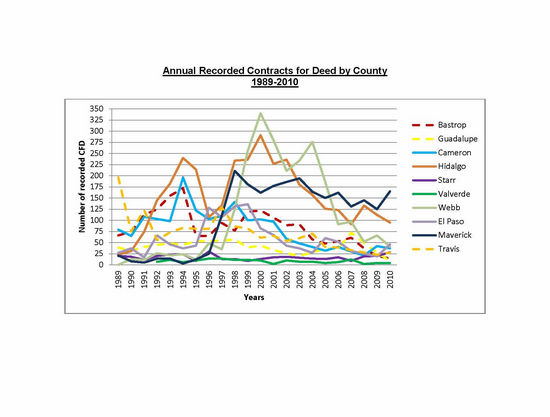Texas Dept of Housing & Community Affairs Project

“The Contract for Deed Prevalence Project” in Texas Colonias and Informal Low Income Subdivisions
This report was undertaken by researchers at The University of Texas at Austin and examines titling and land acquisition practices in Texas colonias and similar communities on the Texas-Mexico border, as well as interior counties around Austin. The Report is the result of a Contract for Deed Prevalence Research Project (the Project) commissioned by the Texas Department of Housing and Community Affairs, in response to a 2011 recommendation from the Texas Sunset Advisory Commission. The primary aim of the Project was to estimate the current number of recorded and unrecorded Contracts for Deed (CFDs) in Texas colonias in six counties: Cameron, El Paso, Hidalgo, Maverick, Starr and Webb (we also added Val Verde for a portion of the study). Read more >>
Contracts for deeds (Chapter 2) are a widely used mechanism of seller financing in which the seller promises to issue a deed to the buyer only after the buyer has paid the entire agreed purchase price. Starting in 1995, the Texas Legislature adopted a series of regulations bringing CFDs under stricter regulation, including a requirement in the Texas Property Code that CFDs be recorded although consumers often lack information on the importance of recording their documents in the county clerk records or do not understand the process for recording their documents.
In addition to looking at hard counts of CFDs, we also set out to understand more deeply: (1) who is still using CFD and why; (2) the full range of homeownership acquisition methods in colonias and the extent to which these areas are related to increased informality and a concomitant “clouding” of title; (3) what is happening to ownership interests in older colonias as the aging owners die and pass on their interests; and (4) what barriers and issues are homeowners facing in obtaining secure, clean title to their homesteads. Since we know from prior research that conditions found in colonias exist throughout Texas, the Report also set out to examine similar subdivisions in Central Texas, near our base at U.T., with varying degrees of focus on Guadalupe, Hays, Travis, and Bastrop counties.
Our study used a “mixed methods” approach that included interviews with key informants, focus groups, archive analysis, surveys, aerial imaging, etc. The Project was designed in three stages, or phases. Phase One was undertaken primarily in the first four months and focused upon getting a hard count of the recorded CFDs (RCFDs) from 1989 through 2010 in the targeted counties (reported in Chapter 3), as well as assessing the relative current importance of RCFDs against the backdrop of all recorded land sales transactions in each county.
Phase Two of the Project was focused on estimating the numbers of unrecorded CFDs (UCFDs Chapter 4). Since the data for UCFDs are unavailable in government records, the first part of this phase involved sampling and conducting almost 1,300 household surveys in 65 colonias and informal subdivisions in 8 counties (see the first half of Chapter 5 for a data overview) The second part of Phase 2 consisted of painstaking tracking of individual title histories in the County Appraisal District and county clerk records, with assistance from title companies in some counties, to arrive at estimates of UCFDs.
Phase Three of the Project sought to offer more qualitative insights related to titling practices and informality in land transactions and to research major trends and issues arising from current land acquisition processes. We conducted a systematic analysis of the survey database to examine issues such as inheritance, renting, lot abandonment, the evolution of developer practices over time, consumer-to-consumer sales, cross comparisons of newer and older colonias, and lot abandonment (Chapter 5).
The broad conclusions, policy implications and priorities for further research are outlined at Chapter 6 (Chapter 6).
Two sets of folders follow. First is a pdf of the Report itself (full report) also broken down by individual chapters for easier access and reading. There is also a 12pp stand-alone Executive Report and a detailed contents list. Second, are a series of folders containing Methodological Appendices and which contain descriptions of the statistical analysis, colonia descriptions, instruments and protocols used, types of property title, data findings, as well as the actual databases themselves in SPSS, Stata and EXCEL (redacted to remove identifying information). In addition, for those who do not wish to use the full database and software we have prepared a user friendly Matrix which allows the reader to scan the principal variables by county, by type of subdivision (old colonias or newer model subdivisions) and by age of settlement.

